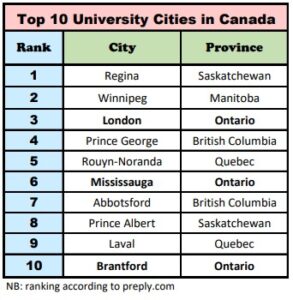Mississauga among top ten university cities in Canada
TORONTO – When it comes to pursuing post secondary education, typically, most people focus on academics. However, campus life and the world beyond also factor into one’s choice in their post secondary education journey. For many, it may also mean moving to a new city or town. With that in mind, Mississauga, comes in as one of the top ten university cities in Canada.
According to Preply, a US-based online tutor platform, Mississauga ranks number six when it comes to Canada’s best university towns and cities. However, there are a million different directions where one could go.
Speak to anyone who has been through the experience and you may get a biased opinion, based on their alma mater. For those who are still in the planning phase, various organizations research and rank the best universities to help narrow people’s focus. In Canada, the University of Toronto most often ranks number one on any given list.
Overall, the organization rated 94 Canadian cities based on a set of indicators. Elements such as affordability, quality of life and economic opportunities for students all factored into the methodology. Regina, Saskatchewan, ranked number one as the best university city in Canada. The city has several post secondary institutions including the University of Regina, Campion College and Saskatchewan Polytechnic.
The city offers a cultured experience full of popular attractions including the Mackenzie Art Gallery, the Regina Conservatory of Music and the Interactive Science Centre.
When it comes to affordability, the cost of rent at about $1,017 for a one-bedroom apartment is about one third of the average monthly salary ($3,735).
Three Ontario cities make the top ten list. Of the three, Mississauga’s growing community is diverse with ethnic groups from around the world. Students can connect with community organizations and events that can expose them to the city’s multicultural diversity and make their university experience more immersive. The city hosts several educational institutions like the University of Toronto, Canadian College of Business, Science & Technology, the Metalworks Institute and Sheridan College.
Housing is an important factor, especially for non-local students. A one-bedroom apartment costs about $1,890 a month. The average monthly salary of about $4,530 leaves room leaves some in reserve for a drink with friends. On average, a pint of beer costs five dollars Canadian. Also, a mere 20-minute ride on public transit connects students with the sights, sounds and attractions in Toronto.
Two other Ontario university cities rank among the top ten. London ranks third while Brantford falls in at tenth. Both appeal to students on account of affordability. London, located in Southwestern Ontario, is rich in history and has a vibrant arts and music scene. It also offers many urban conveniences and cultural activities. Several institutions are based in London, including the University of Western Ontario; Fanshawe College of Applied Arts and Technology, St. Peter’s Seminary and Westervelt College.
A little more budget-friendly than some bigger cities, the cost of rent is a bit more digestible at $1,490 per month. The average salary in the area is about $4,170, but beer at $6/pint, costs about a dollar more than in Mississauga.
About an hour drive west of Mississauga is the city of Brantford. Known as the city where Alexander Graham Bell invented the telephone, and the birth place of Wayne Gretzky, Brantford is home to several academic institutions including, Wilfrid Laurier University; Conestoga College and Six Nations Polytechnic.
Students can immerse themselves in the arts and culture of the city. The Woodland Cultural Centre offers people the opportunity to experience traditional Native crafts and the option to study First Nations languages. However, the average monthly salary is about $1,910. The relatively higher cost of living means finding more budget-friendly activities. Rent costs an average of $1,300/month.
Living in any of these cities may give students better exposure to diverse cultures and potentially enable them to experience a better learning process and help them achieve their goals and aspirations.
Photo credit: Brooke Cagle, Unsplash





